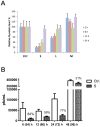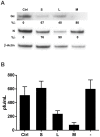Small interfering RNA inhibition of Andes virus replication
- PMID: 24924189
- PMCID: PMC4055710
- DOI: 10.1371/journal.pone.0099764
Small interfering RNA inhibition of Andes virus replication
Abstract
Andes virus (ANDV) is the most common causative agent of hantavirus pulmonary syndrome (HPS) in the Americas, and is the only hantavirus associated with human-to-human transmission. Case fatality rates of ANDV-induced HPS are approximately 40%. There are currently no effective vaccines or antivirals against ANDV. Since HPS severity correlates with viral load, we tested small interfering RNA (siRNA) directed against ANDV genes as a potential antiviral strategy. We designed pools of 4 siRNAs targeting each of the ANDV genome segments (S, M, and L), and tested their efficacy in reducing viral replication in vitro. The siRNA pool targeting the S segment reduced viral transcription and replication in Vero-E6 cells more efficiently than those targeting the M and L segments. In contrast, siRNAs targeting the S, M, or L segment were similar in their ability to reduce viral replication in human lung microvascular endothelial cells. Importantly, these siRNAs inhibit ANDV replication even if given after infection. Taken together, our findings indicate that siRNAs targeting the ANDV genome efficiently inhibit ANDV replication, and show promise as a strategy for developing therapeutics against ANDV infection.
Conflict of interest statement
Figures





Similar articles
-
In vitro and in vivo activity of ribavirin against Andes virus infection.PLoS One. 2011;6(8):e23560. doi: 10.1371/journal.pone.0023560. Epub 2011 Aug 10. PLoS One. 2011. PMID: 21853152 Free PMC article.
-
Andes virus M genome segment is not sufficient to confer the virulence associated with Andes virus in Syrian hamsters.Virology. 2004 Aug 15;326(1):130-9. doi: 10.1016/j.virol.2004.05.018. Virology. 2004. PMID: 15262501
-
Andes virus regulation of cellular microRNAs contributes to hantavirus-induced endothelial cell permeability.J Virol. 2010 Nov;84(22):11929-36. doi: 10.1128/JVI.01658-10. Epub 2010 Sep 15. J Virol. 2010. PMID: 20844033 Free PMC article.
-
Hantavirus pulmonary syndrome.Virus Res. 2011 Dec;162(1-2):138-47. doi: 10.1016/j.virusres.2011.09.017. Epub 2011 Sep 17. Virus Res. 2011. PMID: 21945215 Review.
-
Development of small-molecule inhibitors against hantaviruses.Microbes Infect. 2020 Jul-Aug;22(6-7):272-277. doi: 10.1016/j.micinf.2020.05.011. Epub 2020 May 20. Microbes Infect. 2020. PMID: 32445882 Review.
Cited by
-
GS-5734 and its parent nucleoside analog inhibit Filo-, Pneumo-, and Paramyxoviruses.Sci Rep. 2017 Mar 6;7:43395. doi: 10.1038/srep43395. Sci Rep. 2017. PMID: 28262699 Free PMC article.
-
Hemorrhagic fever of bunyavirus etiology: disease models and progress towards new therapies.J Microbiol. 2017 Mar;55(3):183-195. doi: 10.1007/s12275-017-7029-8. Epub 2017 Feb 28. J Microbiol. 2017. PMID: 28243938 Review.
-
Vaccines and Therapeutics Against Hantaviruses.Front Microbiol. 2020 Jan 30;10:2989. doi: 10.3389/fmicb.2019.02989. eCollection 2019. Front Microbiol. 2020. PMID: 32082263 Free PMC article. Review.
-
Hantavirus: an overview and advancements in therapeutic approaches for infection.Front Microbiol. 2023 Oct 12;14:1233433. doi: 10.3389/fmicb.2023.1233433. eCollection 2023. Front Microbiol. 2023. PMID: 37901807 Free PMC article. Review.
-
Endocytic Pathways Used by Andes Virus to Enter Primary Human Lung Endothelial Cells.PLoS One. 2016 Oct 25;11(10):e0164768. doi: 10.1371/journal.pone.0164768. eCollection 2016. PLoS One. 2016. PMID: 27780263 Free PMC article.
References
-
- Doyle TJ, Bryan RT, Peters CJ (1998) Viral hemorrhagic fevers and hantavirus infections in the Americas. Infectious Disease Clinics of North America 12: 95–110. - PubMed
-
- Chaparro J, Vega J, Terry W, Vera JL, Barra B, et al. (1998) Assessment of person-to-person transmission of hantavirus pulmonary syndrome in a Chilean hospital setting. Journal of Hospital Infection 40: 281–285. - PubMed
-
- Ferres M, Vial P, Marco C, Yanez L, Godoy P, et al. (2007) Prospective evaluation of household contacts of persons with hantavirus cardiopulmonary syndrome in chile. Journal of Infectious Diseases 195: 1563–1571. - PubMed
-
- Schmaljohn CS, Nichol ST (2007) Bunyaviridae. In: Fields BN, Knipe DM, Howley PM, editors. Fields Virology. 5th ed. Philadelphia: Wolters Kluwer Health/Lippincott Williams & Wilkins. pp. 1741–1789.
Publication types
MeSH terms
Substances
LinkOut - more resources
Full Text Sources
Other Literature Sources

